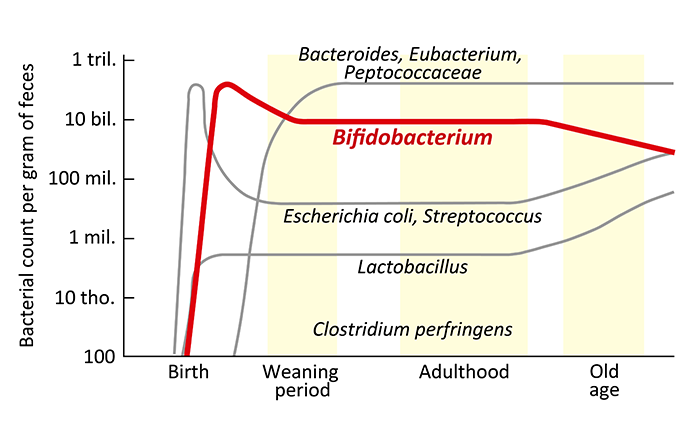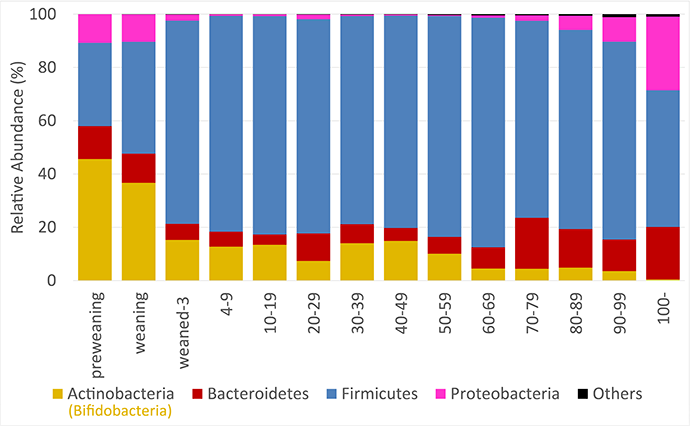Bifidobacteria and Gut Microbiota
Importance of Balanced Gut Microbiota
Human Gut Microbiota

The human gut is home to trillions of microorganisms, including at least 1,000 different species of known bacteria that coexist in a balanced manner. They are collectively known as gut microbiota (formerly termed intestinal flora).
The gut microbiota consists of microbes that are both beneficial and potentially harmful. It is thought that maintaining the right balance of the gut microbiota, immune responses, and the key metabolites such as short-chain fatty acids, vitamins, etc. are vital for host physiology and immunity.
Gut Dysbiosis
![[Gut Dysbiosis]Cancer/Liver Disease/Cardiovascular Disease/Autism/Asthma/Allergy/IBS/Infection/Renal Calculus/Diabetes/IBD/Obesity](/about/story/microbiota/img/index_im02.png)
The development of a stable and diverse gut microbiota is essential to various host physiological functions. The composition of our microbiota changes throughout the entire life, from birth to old age, and is affected by various environmental factors such as stress, aging, use of antibiotics, unbalanced diet, lack of exercise, etc.
Studies have shown that dysbiosis - a loss of balance in gut microbiota - is associated with disease pathologies.
Bifidobacteria: The Major Member of Human Gut Microbiota
Bifidobacteria, along with lactobacilli, are the most common species of probiotics. Despite some common properties, bifidobacteria and lactobacilli belong to two different taxonomic groups. Bifidobacteria are the major members of beneficial bacteria present in the human gut. The bacterial counts of bifidobacteria outnumber those of lactobacilli[1] by a factor of several hundred in the human gastrointestinal tract, particularly in the colon. On this basis, bifidobacteria are seen as the species that have adapted to the human intestinal environment. While lactobacilli produce lactic acid as a major end-product of sugars metabolism, bifidobacteria produce both lactic acid and acetic acid, which is beneficial to human health.
| Bifidobacteria | Lactic acid bacteria[1] | |
|---|---|---|
| Cell morphology | Curved, branched, or clubbed rods

|
Cocci or rods


|
| Habitat | Mainly large intestines of human and animal | Generally milk and dairy products, human and animal intestines, fermented foods such as pickled vegetables |
| Sensitivity to oxygen | Unable to live in the presence of oxygen (obligate anaerobes) | Able to live in the presence of oxygen (facultative anaerobe) |
| Main metabolites | Lactic acid + Acetic acid | Lactic acid |
- [1]Refers to typical species belonging to the genus Lactobacillus
 What are Probiotics?
What are Probiotics?According to Joint FAO/WHO Working Group 2002, probiotics are "live microorganisms which when administered in adequate amounts confer a health benefit on the host "[2]. The health benefits of probiotics are mainly to do with gastrointestinal (GI) health. There is a saying that "a healthy gut is the key to a healthy body".
- [2]Food and Agriculture Organization of the United Nations (FAO). 2001.Health and Nutritional Properties of Probiotics in Food including Powder Milk with Live Lactic Acid Bacteria,
Bifidobacteria Colonization in Human Gut
Changes in Gut Microbiota Composition with Age

The composition of human gut microbiota changes with age, and alterations in this composition influence human health. In the early 1970s, a study using culture-based method demonstrated that the number of intestinal bacteria changes with age (Mitsuoka, 1973).
More recently, using a next-generation sequencer - a device that has resulted in dramatic advances in gut microbiome analysis - Morinaga Milk identified the sequential changes in the gut microbiota composition of 367 healthy Japanese subjects aged zero to 104 years. The findings provided insights into the patterns of change in human gut microbiota with age.
Bifidobacteria Levels Decrease With Age

Bifidobacterium is an important genus within the phylum Actinobacteria that predominantly inhabits the infant gut. The levels of bifidobacteria started to decrease after weaning and continued to decline gradually but remain considerably stable during adulthood. Thereafter, the population of bifidobacteria decreases again in old age. In contrast, the proportions of bacteria belonging to the phylum Proteobacteria - some of which are potentially pathogenic and can cause food poisoning - started to increase in the 60s and kept increasing with age (Odamaki et al., 2016).
